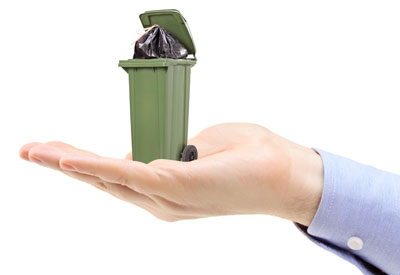Reduce
Minnesota State Statute (115A.02) dictates that source reduction is the preferred waste management method – the top of the waste management hierarchy. Source reduction, also known as waste prevention, means not using a material or item in the first place. Reduction can lead to significant cost savings, as you pay for that material multiple times – the cost to purchase the material, handle and store it, process it, and ultimately dispose of it.
Reduce waste at the source by changing:
- Procedures, or practices that people follow
- Processes or equipment to be more efficient
- Products or chemicals to something safer
Examples of source reduction include:
- Minimal packaging
- Eliminating cosmetic painting
- Light-weighting products
- Using compost and mulch instead of mined fertilizer
- Using e-communications instead of paper
- Reducing toxicity in formulations
- Using reusables instead of single-use products, like plastic straws and Styrofoam take-out containers
Examples of changing the procedure:
- Preventive maintenance program
- Inventory control system
- Start-up/shut down procedures
- Improve floor layout for production
- Employee training programs
- Employee incentive programs
- Prevent leaks and spills
- Improved purchasing practices
Examples of changing the process:
- Improve process efficiency through retrofits
- Upgrade to more efficient equipment
- Train staff on proper equipment operation
- Dedicate process equipment for different colors or material types
- Ongoing process evaluation
Examples of changing the product:
- Optimize solution concentration
- Find alternative or substitute chemicals
- Plan and schedule production to minimize chemical use
- Evaluate product formulation needs
- Use aqueous-based products in place of solvents
- Prolong process solution life
Learn more about identifying waste reduction opportunities on our Waste Assessments, Sorts, and Tools page.
Company Examples
The following companies have reduced their waste and emissions and are enjoying the benefits of lower costs and fewer regulations.
- Miller Manufacturing: 2022 – Miller Manufacturing is a company that produces farm, ranch, and pet products. They have two locations of interest, Glencoe and Anoka. An action plan was created to reduce packaging. 50 pallets are shipped from Glencoe to Anoka weekly, amounting to 2,000-4,000 lb. of plastic shrink wrap per year. A recommendation was made to use reusable pallet wrap instead. This could potentially save the company 3,000 lb. of plastic shrink wrap and $6,000 annually. The company is testing this recommendation and it will pay for itself after only 14 months.
- Sappi: 2020 – Sappi is an international pulp and paper company. It has weekly safety talks which are exercises the entire mill discusses and focus on creating a safer working environment. A waste reduction safety talk was given with impressive results. By continuing education and adding additional signage and lids to certain dumpsters, Sappi expects to reduce waste by 30 tons and save $5,900 annually.
- Nordic Ware: 2016 – Nordic Ware is a kitchenware manufacturer. As part of the manufacturing process, paint is applied to multiple products. A recommendation was made to use an overhead coatings line, hanging up to six products per fixture and applying paint on both sides in one pass, and then sending the line through an infra-red (IR) curing oven. It was estimated 3,300 gallons of paint and 6.80 tons of Volatile Organic Compounds (VOCs) could be saved.
- K-Bar Industries (2002). This company manufactures metal outdoor-maintenance power equipment, shop equipment and parts and paints over paints over 3,000 parts/year using powder coating system. Through improved inspection of reject parts, increased operator awareness, process changes, and an upgraded paint system, the company saved $44,000 annually and reduced reject parts by 50%.
- Marathon Ashland (1998). Through an intern project, the company minimized solvent-based cleaning by installing new cabinet aqueous spray washer and eight new parts washers with filtration, using terpene first followed by solvent-based cleaner for final cleaning, and substituting foam cleaner with greater contact time and less water clean-up. In all, 40 gallons of chlorinated solvents were eliminated annually and the company is saving $39,000 a year.
- Medtronic (2001). By implementing Design for the Environment strategies into their product design, Medtronic is able to reduce waste and be more efficient.
Additional Resources
Getting Started
- Cutting Wastes, Compliance Costs (MnTAP Source, 2002)
- Pollution Prevention Resource Exchange (P2Rx)
- Waste Reduction (MPCA)
- Waste Reduction Resources (US EPA)
- Source Reduction Now! (MPCA)
- Business Guide for Reducing Solid Waste (US EPA)
- Waste Prevention and Sustainability: Case Studies for Local Governments
- Five ways to reduce waste and costs on your company’s campus
Purchasing and Supply Chain
- Environmentally Preferable Purchasing (US EPA)
- Greening your supply chain (MnTAP)
- Environmentally preferable purchasing (MnTAP)
- Buying Green Case Studies
Paper
- Office paper reduction (MPCA)
- Paper Calculator: Determines environmental impact of use of paper, with options for different types of paper and recycled content percentages (Environmental Defense)
- Reduce your junk mail (MPCA)
- Steps for purchasing environmentally preferable paper
Toxicity reduction
- Toxics Use Reduction Institute
- Safer Choice (US EPA)
- OECD Substitution and Alternatives Assessment Toolbox
- Transitioning to Safer Chemicals: A Toolkit for Employers and Workers (OSHA)
- Green Alternatives Wizard: database that provides information on alternatives to hazardous chemicals or processes
